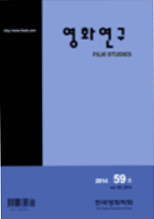- 영문명
- A Study on New Characteristics of Japanese Films in the 1960s∼1970s: Focusing on Antithesis Trend of Tradition in 4 Directors
- 발행기관
- 한국영화학회
- 저자명
- 전평국
- 간행물 정보
- 『영화연구』제53호, 269~307쪽, 전체 39쪽
- 주제분류
- 예술체육 > 예술일반
- 파일형태
- 발행일자
- 2012.09.30

국문 초록
영문 초록
This study considered a research on new trend of Japanese films in the 1960s∼1970s focusing on 4 directors. Like the West, even Japan was in the era of a whirlpool politically and socially enough to have it as 'one turning point of paradigm' with entering the 1960s. Four directors violently shake the whole of terrain in Japanese film with 'new wave,' calling even a film as old generation, with new challenge and innovation standing against the period before it. These directors proceed with making their films with new form, style and theme while fighting with the existing order, politics, and ideology with revolting against the tradition of Japanese film. Oshima Nagisa, who led the new-wave movement, proceeded with pursuing development in a film with new theme, new assertion, and new method while fighting with traditional film most combatively and innovatively. Imamura Shohei pioneered aesthetics called Imamura realism with inquiring into a problem about 'what is Japanese style'(Japanese identity), by firmly maintaining attitude dubbed 'spirit of denegation,' through challenging Mizoguchi's tradition & emotion, and aestheticism & universal humanism value. Suzuki Seijun took the lead in vitality of Japan's popular culture with cultish popularity by making a film of standing for decadence and aestheticism with experimental form and destructive informality in the limit of genre, with odd and unique video and style. And Yamada Yoji proceeded with opening new chapter of Japanese film with humor and wit on a petit bourgeois's fragmentary thought about life even while proceeding with continuing the consistent material, character, and story writing technique by displaying 'artisan spirit' within the film-making system peculiar to Japan. These films, which are expressed with 'vitalism,' are greatly differentiated from their original works in young & energic hero, in strongly social-criticism element through sex and violence, in negation of humanism and sentimentalism, in a mixed form of using documentary style, in looseness & open composition in the structure of story, and in radical experiment of a form and contents. The Japanese films following the 1960s∼1970s amid this trend come to develop into the so-called 'diversification' and 'internalization' era by creating films in diverse genres and forms such as commercial & art films, experiment, documentary, and animation with many challenges and responses in the middle of the affiliation and cooperation system of major company and independent production.
목차
1. 서론
2. 오시마 나기사(大島渚, 1932∼)의 영화 세계
3. 이마무라 쇼헤이(今村昌平, 1926-2006)의 영화 세계
4. 스즈키 세이준(鈴木淸順, 1923~)의 영화 세계
5. 야마다 요지(山田洋次, 1931~)의 영화 세계
6. 결론
키워드
해당간행물 수록 논문
참고문헌
최근 이용한 논문
교보eBook 첫 방문을 환영 합니다!

신규가입 혜택 지급이 완료 되었습니다.
바로 사용 가능한 교보e캐시 1,000원 (유효기간 7일)
지금 바로 교보eBook의 다양한 콘텐츠를 이용해 보세요!




